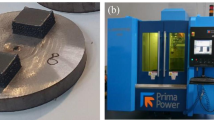Abstract
All thermal and thermochemical methods for the manufacturing of surface hardened components demand the application of high temperatures which are accompanied by significant emission of CO2. At the ECO-Center of the Foundation Institute of Materials Science in Bremen, alternative manufacturing processes have been developed, which avoid a final heat treatment and allow surface hardening with a significantly reduced energy consumption. Two of these approaches are grind hardening and cold surface hardening. The grind hardening effect uses the heat produced by the machining process. The high temperatures combined with self-quenching of the workpiece generate a short-term austenitization and subsequent martensitic transformation. Cold surface hardening represents a way to profit from special properties of the machined materials. Workpieces with a high amount of metastable austenite can be machined in their soft state and a subsequent induction of high stresses by a mechanical process such as deep rolling results in a martensitic transformation of the surface. Both process chains are applicable for the manufatcuring of surface hardened components with high surface quality and compressive residual stresses at the surface. In the future, the alternative process chains presented combined with reliable tools for the prediction of CO2-emission resulting from machining processes will allow a significant reduction of CO2 per produced component.
Access this chapter
Tax calculation will be finalised at checkout
Purchases are for personal use only
Preview
Unable to display preview. Download preview PDF.
Similar content being viewed by others
References
Field, M.; Kahles, J.F.: Review of Surface Integrity of Machined Components. Annals of the CIRP, 20/2, 1971, pp. 153-163.
Hisakado, T.: The influence of surface roughness on abrasive wear. Wear, 41/1, 1977, pp. 179-190.
Kalin, M.; Jahanmir, S.; Iwes, L.K.: Effect of counterface roughness on abrasive wear of hydroxyapatite. Wear, 252/9-10, 2002, pp. 679-685.
Hiroyuki, S.: The effect on fatigue life of residual stress and surface hardness resulting from different cutting conditions of 0.45%C steel. International Journal of Machine Tools and Manufacture, 45/2, 2005, pp. 131-136.
Brockhoff, T.; Brinksmeier, E.: Grind-Hardening: A Comprehensive View. Annals of the CIRP, 48/1, 1999, pp. 255-260.
Kristoffersen, H.; Vomacka, P.: Influence of process parameters for induction hardening on residual stresses. Materials & Design, 22/8, 2001, pp. 637-644.
Pantleon, K.; Keßler, O.; Hoffmann, F.; Mayr, P.: Induction surface hardening of hard coated steels. Surface and Coatings Technology, 120-121, 1999, pp. 495-501.
Jung, M.; Walter, A.; Hoffmann, F.; Mayr, P.: High Pressure Nitriding of Austenitic Stainless Steels. Proc. 11th Congress of the IFHT / 4th ASM Heat Treatment and Surface Engineering Conf. in Europe, 19.-21.10.98, Florence, Italy, Vol. 1 (Ed.: D. Fiarro, E.J. Mittemeijer), Associazione Italiana di Metallurgia, Milan, 1998, pp. 281-289.
Clausen, B.; Surm, H.; Hoffmann, F. Zoch, H.-W. The influence of carburizing on size and shape changes. Mat.-wiss. u. Werkstofftech., 40, 2009, 5-6, pp. 415-419.
Brinksmeier, E.; Brockhoff, T.: Randschicht-Warmebehandlung durch Schleifen. Journal of Heat Treatment and Materials (HTM), 49/5, 1994, pp. 327-330.
Zhang, J.; Ge, P.; Jen, T.-C.; Zhang, L.: Experimental and numerical studies of AISI1020 steel in grindhardening. International Journal of Heat and Mass Transfer, 52/ 3-4, 2009, pp. 787-795.
Heinzel, C.: Schleifprozesse verstehen - Zum Stand der Modellbildung und Simulation sowie unterstützender experimenteller Methoden. Habilitation, University of Bremen, 2009.
Brinksmeier, E.; Minke, E.; Wilke, T.: Investigations on Surface Layer Impact and Grinding Wheel Performance for Industrial Grind-Hardening Applications. Annals of the German Academic Society for Production Engineering (WGP), 1, 2005, pp. 35-40.
Zäh, M. F.; Föckerer, T.; Brinksmeier, E.; Heinzel, C.; Huntemann, J.-W.: Experimentelle und numerische Bestimmung der Einhärtetiefe beim Schleifhärten. wtonline, 1/2, 2009, pp. 49-55.
Zäh, M. F.; Brinksmeier, E.; Heinzel, C.; Huntemann, J.-W.; Föckerer, T.: Experimental and numerical identification of process parameters of grind-hardening and resulting part distortions. Annals of the German Academic Society for Production Engineering (WGP), 3, 2009, pp. 271-279.
Brinksmeier, E., Garbrecht, M., Meyer, D.: Cold surface hardening. Annals of the CIRP, 57/1, 2008, pp. 541-544.
Garbrecht, M.: Mechanisches Randschichthärten in der Fertigung, Dr.-Ing. Dissertation, University of Bremen, 2006.
Röttger, K.: Walzen hartgedrehter Oberflächen. Dissertation Dr.-Ing. RWTH Aachen, Shaker Verlag, Aachen, 2003.
Brinksmeier, E., Garbrecht, M., Meyer, D., Dong, J.: Surface Hardening by Strain Induced Martensitic Transformation. Annals of the German Academic Society for Production Engineering (WGP), 2, 2008, pp. 109-116.
Meyer, D., Dong, J., Garbrecht, M., Hoffmann, F., Brinksmeier, E., Zoch, H.-W.: Mechanisch induziertes Härten. Journal of Heat Treatment and Materials (HTM), 65/1, 2010, pp. 37-45.
Müller, E.; Engelmann, J.; Strauch, J.: Energieeffizienz als Zielgröße in der Fabrikplanung. wt Werkstattstechnik online, 2008, Heft 7/8.
Neugebauer, R.: Energieeffizienz in der Produktion, Untersuchung zum Handlungs- und Forschungsbedarf, Fraunhofer Gesellschaft, 2008.
Author information
Authors and Affiliations
Editor information
Editors and Affiliations
Rights and permissions
Copyright information
© 2010 Springer-Verlag London Limited
About this paper
Cite this paper
Brinksmeier, E., Meyer, D., Garbrecht, M., Huntemann, JW., Larek, R. (2010). Reduced Energy Consumption by Adapted Process Chains. In: Hinduja, S., Li, L. (eds) Proceedings of the 36th International MATADOR Conference. Springer, London. https://doi.org/10.1007/978-1-84996-432-6_90
Download citation
DOI: https://doi.org/10.1007/978-1-84996-432-6_90
Publisher Name: Springer, London
Print ISBN: 978-1-84996-431-9
Online ISBN: 978-1-84996-432-6
eBook Packages: EngineeringEngineering (R0)




